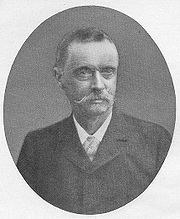
August Mau
Encyclopedia

Germany
Germany , officially the Federal Republic of Germany , is a federal parliamentary republic in Europe. The country consists of 16 states while the capital and largest city is Berlin. Germany covers an area of 357,021 km2 and has a largely temperate seasonal climate...
art historian
History of art
The History of art refers to visual art which may be defined as any activity or product made by humans in a visual form for aesthetical or communicative purposes, expressing ideas, emotions or, in general, a worldview...
and archaeologist
Archaeology
Archaeology, or archeology , is the study of human society, primarily through the recovery and analysis of the material culture and environmental data that they have left behind, which includes artifacts, architecture, biofacts and cultural landscapes...
who worked with the Deutsches Archäologisches Institut while studying and classifying the Roman
Ancient Rome
Ancient Rome was a thriving civilization that grew on the Italian Peninsula as early as the 8th century BC. Located along the Mediterranean Sea and centered on the city of Rome, it expanded to one of the largest empires in the ancient world....
paintings at Pompeii
Pompeii
The city of Pompeii is a partially buried Roman town-city near modern Naples in the Italian region of Campania, in the territory of the comune of Pompei. Along with Herculaneum, Pompeii was destroyed and completely buried during a long catastrophic eruption of the volcano Mount Vesuvius spanning...
, which was destroyed with the town of Herculaneum
Herculaneum
Herculaneum was an ancient Roman town destroyed by volcanic pyroclastic flows in AD 79, located in the territory of the current commune of Ercolano, in the Italian region of Campania in the shadow of Mt...
by volcanic eruption
Volcano
2. Bedrock3. Conduit 4. Base5. Sill6. Dike7. Layers of ash emitted by the volcano8. Flank| 9. Layers of lava emitted by the volcano10. Throat11. Parasitic cone12. Lava flow13. Vent14. Crater15...
in 79 AD. The paintings were in remarkably good condition due to the preservation by the volcanic ash
Volcanic ash
Volcanic ash consists of small tephra, which are bits of pulverized rock and glass created by volcanic eruptions, less than in diameter. There are three mechanisms of volcanic ash formation: gas release under decompression causing magmatic eruptions; thermal contraction from chilling on contact...
that covered the city. Mau first divided these paintings into the four Pompeian Styles
Pompeian Styles
The Pompeian Styles are four periods which are distinguished in ancient Roman mural painting. They were originally delineated and described by the German archaeologist August Mau, 1840 – 1909, from the excavation of wall paintings at Pompeii, which is one of the largest group of surviving examples...
still used as a classification.
Mau was born in Kiel
Kiel
Kiel is the capital and most populous city in the northern German state of Schleswig-Holstein, with a population of 238,049 .Kiel is approximately north of Hamburg. Due to its geographic location in the north of Germany, the southeast of the Jutland peninsula, and the southwestern shore of the...
, where he read Classical Philology at the University of Kiel
University of Kiel
The University of Kiel is a university in the city of Kiel, Germany. It was founded in 1665 as the Academia Holsatorum Chiloniensis by Christian Albert, Duke of Holstein-Gottorp and has approximately 23,000 students today...
, and then at the University of Bonn
University of Bonn
The University of Bonn is a public research university located in Bonn, Germany. Founded in its present form in 1818, as the linear successor of earlier academic institutions, the University of Bonn is today one of the leading universities in Germany. The University of Bonn offers a large number...
. He moved to Rome, for reasons of ill-health, in 1872, where he became Secretary to the German Archaeological Institute and catalogued the holdings of its extensive library. His interests lay above all in Pompeii, with inscriptions and Roman wall paintings, where he built upon the earlier work published by Wolfgang Helbig
Wolfgang Helbig
Wolfgang Helbig was a German classical archaeologist who was a native of Dresden.From 1856 to 1861 he studied philology and archaeology at the Universities of Göttingen and Bonn, and in 1862 became a member of the German Archaeological Institute to Rome...
and Giuseppe Fiorelli
Giuseppe Fiorelli
Giuseppe Fiorelli was an Italian archaeologist born in Naples, Italy. His excavations at Pompeii helped preserve the city.Fiorelli's initial work at Pompeii was completed in 1848. He was then imprisoned for some time because his radical approach to archaeology and strong nationalist feelings...
.
Publications
- Pompejanische Beiträge. Reimer, Berlin 1879
- Geschichte der decorativen Wandmalerei in Pompeji. Reimer, Berlin 1882.
- Führer durch Pompeji. Furchheim, Naples 1893
- Pompeji in Leben und Kunst. Engelmann, Leipzig 1900
- Katalog der Bibliothek des Kaiserlich Deutschen Archäologischen Instituts in Rom. Löscher, Rome In parts, 1913–1932,
Further reading
- Reinhard Lullies (ed.): Archäologenbildnisse. Porträts und Kurzbiographien von klassischen Archäologen deutscher Sprache. (Zabern, Mainz) 1988. ISBN 3-8053-0971-6

